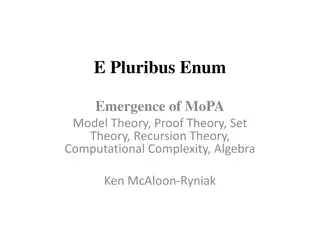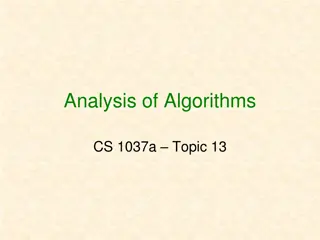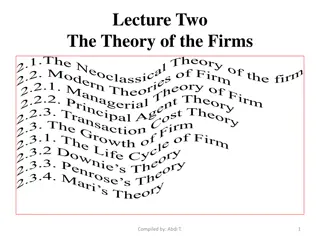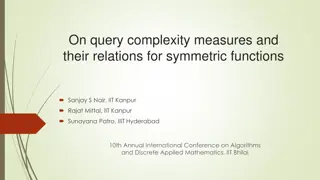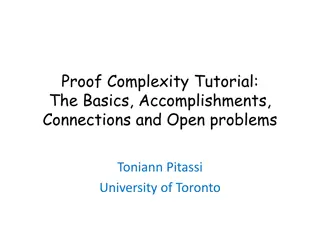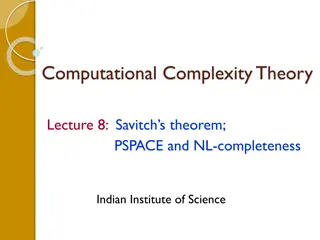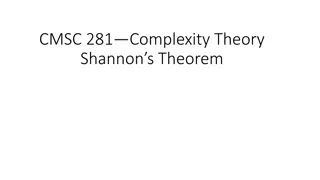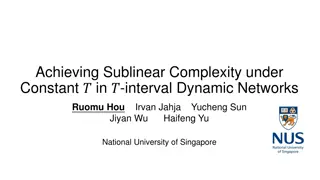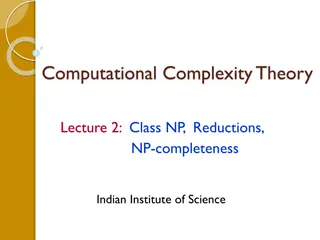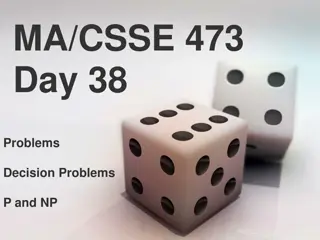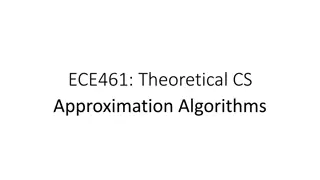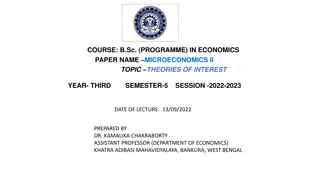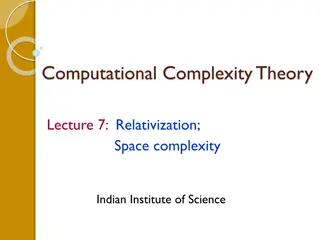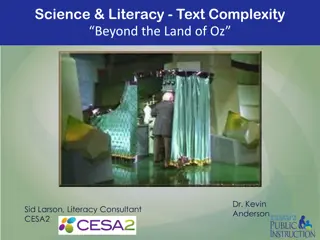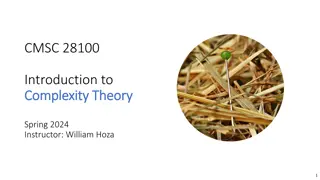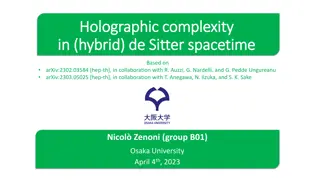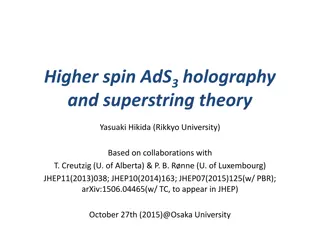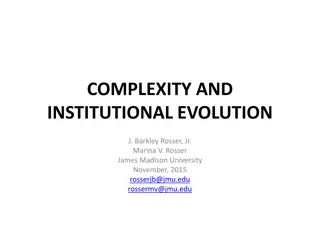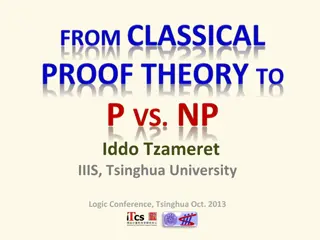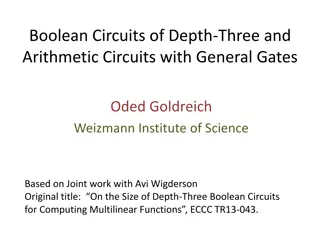Complexity Theory in C++
Delve into the world of Complexity Theory with Cynthia Bailey Lee's peer instruction materials on P/NP definitions, decision vs. optimization problems, and the concept of O(2^n) time complexity. Explore the distinctions between problems in P and NP sets, grasp the implications of problem-solving speed, and gain insights into the significance of efficient algorithms.
Download Presentation

Please find below an Image/Link to download the presentation.
The content on the website is provided AS IS for your information and personal use only. It may not be sold, licensed, or shared on other websites without obtaining consent from the author.If you encounter any issues during the download, it is possible that the publisher has removed the file from their server.
You are allowed to download the files provided on this website for personal or commercial use, subject to the condition that they are used lawfully. All files are the property of their respective owners.
The content on the website is provided AS IS for your information and personal use only. It may not be sold, licensed, or shared on other websites without obtaining consent from the author.
E N D
Presentation Transcript
Creative Commons License CS2 in C++ Peer Instruction Materials by Cynthia Bailey Lee is licensed under a Creative Commons Attribution-NonCommercial- ShareAlike 4.0 International License. Permissions beyond the scope of this license may be available at http://peerinstruction4cs.org. CS106X Programming Abstractions in C++ Cynthia Bailey Lee
2 Today s Topics 1. Quick P/NP vocabulary 2. Just how slow is O(2n)? 3. We can t afford to just not solve problems that are NP-hard. So what can we do?
Quick P/NP definitions P and NP are sets of problems
Quick P/NP definitions P and NP are sets of problems A problem is in P if it can be solved in polynomial time* *on a deterministic Turning machine take CS103! Ex: an algorithm exists that solves it in O(n5) A problem is in NP if we could answer the question in polynomial time IF we had unlimited parallelism and/or omniscient guessing of what to do next at key decision junctures* *this is a non- deterministic Turning machine take CS103!
Quick P/NP definitions P and NP are sets of problems A problem is in P if it can be solved in polynomial time* *on a deterministic Turning machine take CS103! Ex: an algorithm exists that solves it in O(n5) A problem is in NP if If P NP, then all you need to know is that problems in NP (and not in P) take at least O(2n) time on reasonable computers that actually exist
Decision vs Optimization For the purposes of this class, we will consider both of these kinds of problems: Decision problem Ex: Is there a route through all 64 cities with total length <= k? Optimization problem Ex: What is the smallest total length route through all 64 cities? (I mention this distinction because, in complexity theory, these two categories are often treated separately)
Just how slow is O(2n)? (Review from earlier this quarter, when we talked about na ve recursion Fibonacci vs recursion with memoization.)
Context Computers today are unbelievably fast This (relatively weak) tablet can do 2.4 billion operations per second! Wow! So if we really need to know the answer to an NP-hard question, can t we just wait a while? Let it run overnight?
log2n n n log2n n2 2n 4 2 8 16 16 8 3 24 64 256 16 4 64 256 65,536 32 5 160 1,024 4,294,967,296 1.43 seconds 64 6 384 4,096 Easy! 128 7 896 16,384 256 8 2,048 65,536 512 9 4,608 10,240 (.000003s) 262,144 1,048,576 (.0003s) 1,024 10 1210000000000000000 (403333333s = 767 years) 1,100, 000,000 33038341600 30 (11s)
log2n n n log2n n2 2n 4 2 8 16 16 8 3 24 64 256 16 4 64 256 65,536 Easy! 32 5 160 1,024 4,294,967,296 1.43s 64 6 384 4,096 1.84 x 1019 194 YEARS 128 7 896 16,384 NOT easy! 256 8 2,048 65,536 512 9 4,608 10,240 (.000003s) 262,144 1,048,576 (.0003s) 1,024 10 1210000000000000000 (403333333s = 767 years) 1,100, 000,000 33038341600 30 (11s)
log2n n n log2n n2 2n 4 2 8 16 16 8 3 24 64 256 16 4 64 256 65,536 32 5 160 1,024 4,294,967,296 1.43s 64 6 384 4,096 1.84 x 1019 194 YEARS 128 7 896 16,384 256 8 2,048 65,536 Remember the Marble Game, where you exhaustively tried all possible sequences of moves? There were 32 marbles, so 512 9 4,608 10,240 (.000003s) that game was right at the edge of the cliff in terms of being solvable. 262,144 1,048,576 (.0003s) 1,024 10 1210000000000000000 (403333333s = 767 years) 1,100, 000,000 33038341600 30 (11s)
log2n n n log2n n2 2n 4 2 8 16 16 8 3 24 64 256 16 4 64 256 65,536 32 5 160 1,024 4,294,967,296 64 6 384 4,096 1.84 x 1019 128 7 896 16,384 3.40 x 1038 256 8 2,048 65,536 1.16 x 1077 For comparison: there are about 1.0E+80 atoms in the universe. No big deal. 512 9 4,608 10,240 (.000003s) 262,144 1,048,576 (.0003s) 1,024 10 1210000000000000000 (403333333s = 767 years) 1,100, 000,000 33038341600 30 (11s)
log2n n n log2n n2 2n 4 2 8 16 16 8 3 24 64 256 16 4 64 256 65,536 32 5 160 1,024 4,294,967,296 64 6 384 4,096 1.84 x 1019 128 7 896 16,384 3.40 x 1038 256 8 2,048 65,536 1.16 x 1077 512 9 4,608 10,240 (.000003s) 262,144 1,048,576 (.0003s) 1.34 x 10154 1,024 10 1.80 x 10308 1210000000000000000 (403333333s = 767 years) 1,100, 000,000 33038341600 30 LOL (11s)
Current options 1. Use an approach that finds progressively better and better solutions over time, and let it run as long as you can 2. Use a randomized approach: make randomized choices and hope for the best 3. Use a greedy approach: at each juncture, make what looks to be the best choice for the immediate future (may not be in the big picture) and hope for the best 4. Maybe your specific input data has certain properties that make it easier to solve
These options are not as terrible as you might think For some NP-hard optimization problems, a greedy approach can be guaranteed to find a solution that is close to the best possible solution Greedy (polynomial-time) algorithms can be provably optimal for inputs with specific properties These properties are not uncommon in some settings (ex: Directed, Acyclic Graph ( DAG ) as a special case of general Graphs)
Discussion: Can you describe properties of instances of the Traveling Salesperson Problem that would make the instance provably easy to solve?
Knapsack problem You are packing for a backpacking trip on the John Muir trail, and your pack has capacity W kg You have several items you d like to bring, each one has an associated Weight wi in kg Value vi (say in units of happiness that item will bring you) Which items should you pack to maximize your happiness? This file is licensed under the Creative Commons Attribution 2.0 Generic license. http://commons.wikimedia.org/wiki/File:John_Muir_Trail.jpg You are free:to share to copy, distribute and transmit the work to remix to adapt the work Under the following conditions:attribution You must attribute the work in the manner specified by the author or licensor (but not in any way that suggests that they endorse you or your use of the work).
Knapsack Max capacity: 20kg Items (wi,vi): 0: (4,2), 1:(1,1), 2:(5,3), 3:(5,5), 4:(3,4), 5:(15,14), 6:(3,6), 7:(6,8), 8:(10, 12), 9:(8,8) What do you bring? A. 1,4,6,0,3 (lightest first) B. 5,6,1 (highest value--that fits--first) C. 4,6,7,9 (guess the tactic) D. Other
Knapsack is NP-Hard That means it is only solvable in polynomial time if P=NP However, knapsack has some attractive shortcuts to full optimization
Knapsack: unbounded version Assume you can take as many copies as you want of each item Pretty good solution: Sort items in decreasing order of vi/wi Take as many copies as you can of an item (until you are limited by weight capacity) Then take as many copies as you can of the next item, and so on
Knapsack: unbounded version Assume you can take as many copies as you want of each item Pretty good solution: Sort items in decreasing order of vi/wi Take as many copies as you can of an item (until you are limited by weight capacity) Then take as many copies as you can of the next item, and so on No worse than half the best solution
Knapsack regular version There are polynomial-time approximation algorithms that are guaranteed to find a solution that is close to the optimal solution The solution is within (1- ) factor of the optimal solution
Famous NP-hard Problems Clique Independent Set Vertex Cover Set Cover Traveling salesman Sudoku Graph coloring Super Mario Brothers Subset sum http://en.wikipedia.org/wiki/List_of_NP- complete_problems
NP-complete problems There are hundreds of these problems that can be used to solve each other with a polynomial-time transformation Many are in critical application areas (airline flight scheduling, truck shipping route planning, networking, cryptography) But the best known solutions to all of these take exponential time O(2n) TERRIBLE!!
How to win ONE. MILLION. DOLLARS. //evil laugh// Find a polynomial time function for any one of these Remember, then it follows that we have a polynomial time function for all, because we can transform the others and then call the fast function PS: you will have broken all public-key encryption OR Prove that no such function exists
A* search A* search solves Super Mario Brothers https://www.youtube.com/watch?featur e=player_embedded&v=DlkMs4ZHHr8

 undefined
undefined














